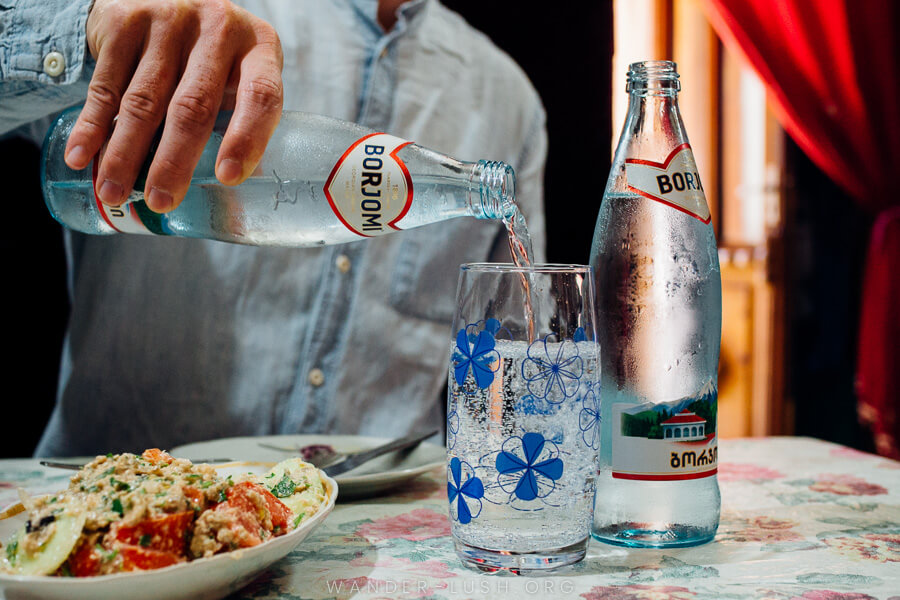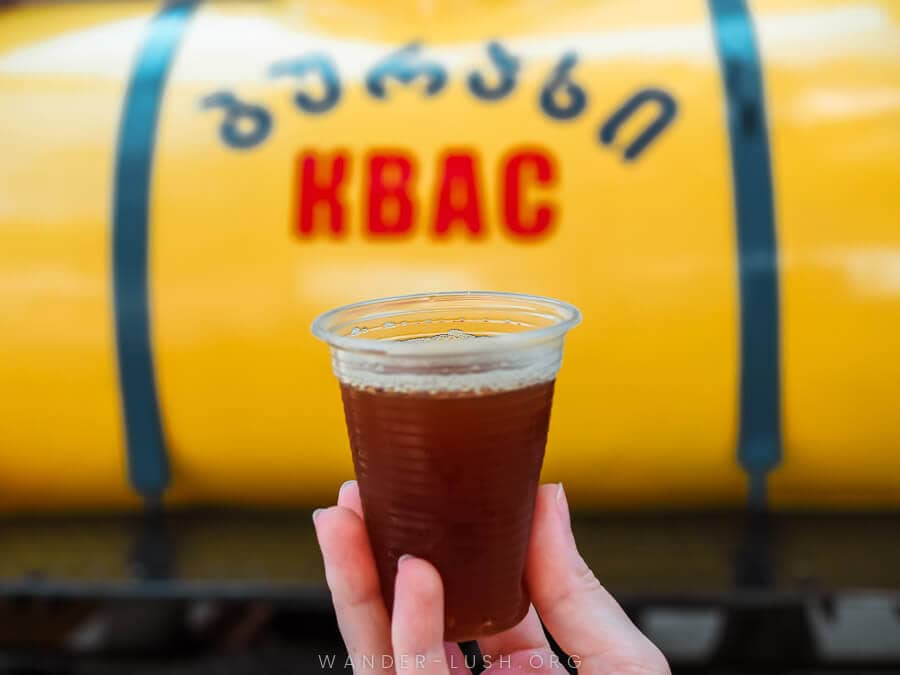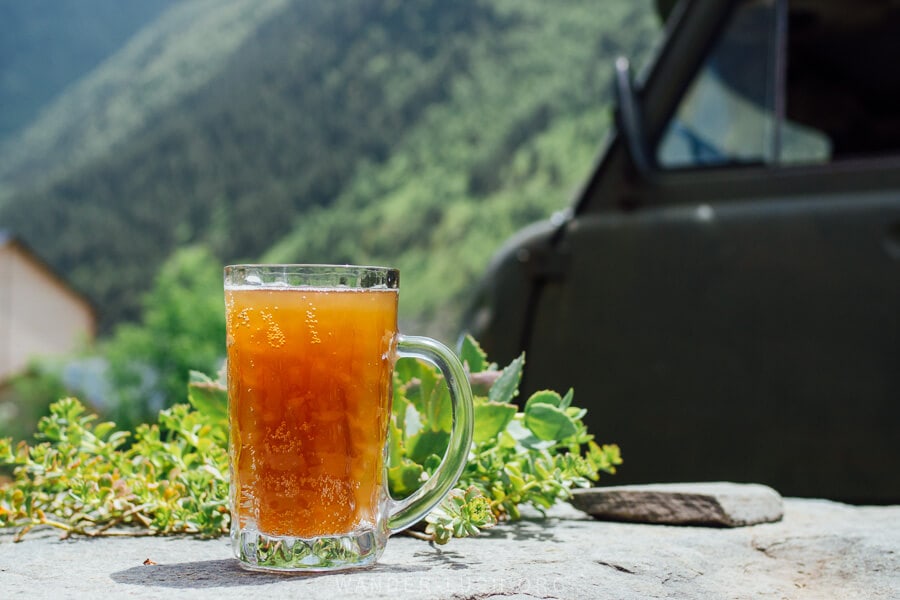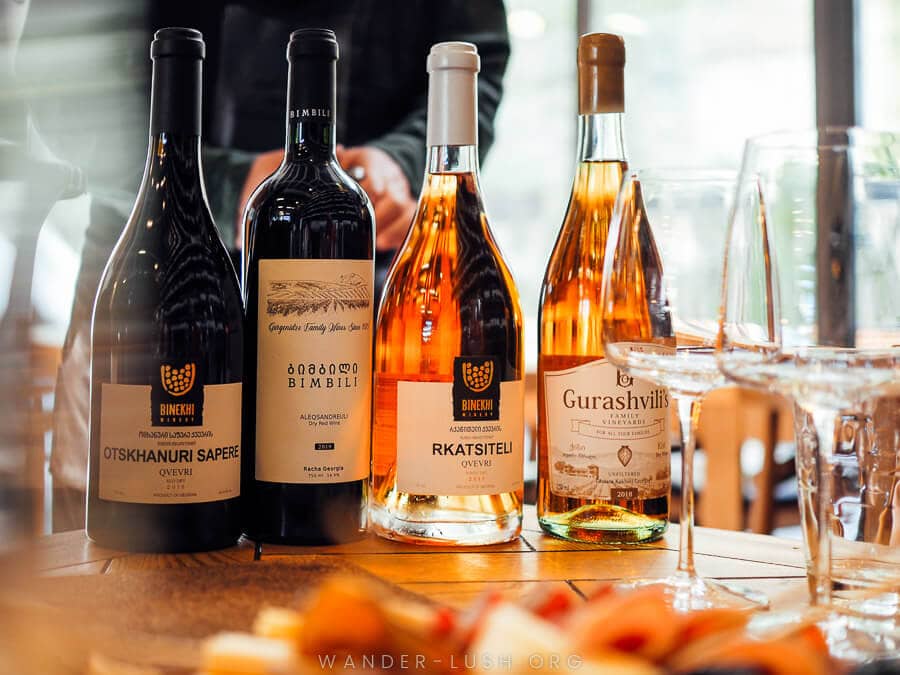With hero dishes such as khachapuri cheese bread and khinkali soup dumplings, Georgian cuisine has an almost mythical status.
What many people don’t realise is that there are many interesting and unusual beverages native to Georgia that also form an important part of the country’s food culture.
And I don’t just mean wine. Important (and delicious!) as it is, there is a whole world of Georgian drinks out there beyond vino – from herbal mountain teas and non-alcoholic beers, to tarragon lemonade and soothing mineral waters.
I have sipped my way around Sakartvelo to bring you this list of special beverages. Here are 15 alcoholic and nonalcoholic traditional Georgian drinks to try.
Please note: This post contains affiliate links, meaning I may earn a commission if you make a purchase by clicking a link (at no extra cost to you). Learn more.
Popular non-alcoholic Georgian drinks
1. Georgian mineral water

Georgia is a land of natural mineral springs and thermal baths. Just look at the name of the capital city: Tbilisi means ‘warm place’, a tribute to the sulfur waters that course beneath the streets and feed the domed sulfur baths in Abanotubani.
Bottled mineral water is one of Georgia’s biggest exports, with a dozen different carbonated and non-carbonated varieties drawn from natural springs around the country.
Each one has a unique mineral composition and some are purported to be good for one’s digestive health – which is why there are balneological health resorts associated with most of these springs. (You can learn more about the waters’ healing properties at the Museum of Georgian Medicine in Tbilisi.)
Sparkling mineral water brands:
- Borjomi (bottled at Georgia’s most famous spring in Borjomi)
- Nabeghlavi (bottled in Guria region – this one is my personal favourite)
- Sairme (bottled in Sairme, near Kutaisi)
- Zekari (bottled near Abastumani in Western Georgia)
- Kobi (bottled in Kobi near Kazbegi)

Still water brands:
- Bakuriani (bottled near the famous ski resort)
- Sno (bottled in Sno village, near Kazbegi)
Bottled mineral water is sold in every restaurant and supermarket. You’ll also notice water springs all over the countryside, especially in sub-tropical Western Georgia. It’s a very popular pastime to fill up a drinking bottle (or even a jerry can!) with fresh mountain water straight from the source. If you’re planning a Georgia road trip, always carry a few empties that you can refill at the various roadside fountains.
Tip: Some mineral waters (including Borjomi) have quite a high salt content – I once heard someone liken it to ‘drinking sea water’. Small sips are key as bloating and headaches might ensue if you drink too much… Trust me, I should know! Nabeghlavi has a milder flavour and I find it much easier to stomach.
2. Lagidze Water


Lagidze Water is a unique Georgian drink that was invented in Kutaisi in 1887 by a pharmacist’s apprentice named Mitrofan Lagidze. Made by combining natural syrup – traditionally dispensed from a soda fountain – with carbonated water, it was designed to be a healthy alternative to imported syrup-based lemonades that were popular at the time.
Some people liken the drink to egg cream. The chocolate and coffee versions have some similarities, but the original fruity and herbal versions are more like a lightly carbonated lemonade.
Lagidze Water comes in an array of Georgia-inspired flavours: Lemon, pear, tarragon, feijoa, cherry, and several different varieties of grape. Some are sweeter than others, but all are slightly fizzy and incredibly smooth.
The brand has a long history – and gorgeous branding. In 1938, Stalin presented Lagidze Water to Harry Truman to one-up the US President’s gift to him – bottles of Coca-Cola. And in 1980, a special edition flavour called Isindi (lemon and apple with bay leaf) was created for the Moscow Olympics.
Mitropan Lagidze and his brother opened their first shop in Tbilisi in 1906. Sadly it is long gone, but a few Georgian restaurants and cafes still serve Lagidze from the fountain, including Amo Rame and Puri Guliani.
The Lagidze Water Cafe on the grounds of Tbilisi’s biggest church, Sameba, is the perfect place to try it. Read more tips for visiting Holy Trinity Cathedral. Update: Unfortunately this branch is closed.
To sample some of the more unusual varieties, head to the food court at Bazari Orbeliani where they have no fewer than 12 Lagidze flavours!
3. Homemade lemonade
A big jug of homemade lemonade is the ideal tonic to take the edge off a hot summer’s day in Tbilisi. One of the country’s most ubiquitous drinks – especially in the warmer months – it’s my lunchtime go-to.
This drink is referred to as homemade lemonade or limonati on most restaurant menus, but the name is a bit deceiving. Like Lagidze Water, the authentic version is made from all-natural ingredients: chopped fruits and muddled herbs combined with sparkling mineral water and ice. Some places add sugar, so be sure to request ushakro (without sugar). We normally order a one-litre jug to share between the two of us.
The best homemade lemonades are prepared with seasonal ingredients: strawberries in spring, kiwi or watermelon in summer, black berries and oranges in late summer, or classic lemon and mint, which you can drink year-round.
4. Bottled Georgian lemonade
Bottled Georgian lemonade is a bit too saccharine sweet for my taste. But it’s a popular beverage nonetheless, and something that’s readily available at all supermarkets and corner stores.
Popular local brands include Natakhtari, Khiliani and Zandukeli. There are some very interesting flavours available, with tarragon lemonade being the most well-known.
Don’t let the very artificial bright green colour put you off – the Zandukeli version at least is purportedly all-natural. Saperavi grape, pear and feijoa are also worth trying.
5. Kompoti (compot)

Compot (kompot), or kompoti as it’s called in Georgian, is another popular fruit-based drink. Variations can be found throughout the countries of the former USSR, the Balkans and the Middle East.
In Georgia, kompoti is made from local, seasonal fruits – strawberry, quince, cornelian cherry, apricot, peach, plum and more. Because the fruit is stewed with sugar, kompoti is a lot sweeter, richer and ‘thicker’ than homemade lemonade.
Kompoti is especially popular in regional Georgia where families use fruit from their gardens to prepare the drink in bulk quantities. Part of the preserving and pickling culture – which is still very much alive in Georgia – it’s usually jarred in summer and autumn and drunk throughout the winter months, often at room temperature.
6. Kvasi (kvass / burakhi / boza)

Another libation that came to Georgia by way of the former USSR, kvasi or kvass is a fermented drink made from rye, sugar and yeast. Burakhi (boza in the Balkans) is similar, but it’s made with millet flour instead of rye and has a thicker consistency.
To my palate, kvasi is like a tangier, watered-down version of a dark beer. The fermentation process means that every batch has a small amount of alcohol, but it’s negligible and that certainly doesn’t stop kids from drinking it!
Kvasi is mostly prepared for tourists and is sold in areas that attract a large number of visitors from Russia and the region – so mainly on the Black Sea Coast. In the high season, vendors can be found all around Batumi selling kvasi on tap from their bright-yellow tanks. I’ve also seen kvass sold on the street in Tbilisi (near Central Station) and in Central Park in Kutaisi.
7. Tushetian Aludi & Kisturi Beer

Tusheti and Pankisi Valley are two of Georgia’s most unique regions, with their own cultures, languages and traditions. On top of two wonderful cuisines, both have a shared heritage of preparing a non-alcoholic fermented ‘beer’ drink.
Tushetian Aludi has immense cultural and spiritual significance and is mostly prepared for summer festivals. Some guesthouses serve it year-round, including Qeto’s Guest House in Dartlo. It’s mild, refreshing, and has a Kombucha-like tang that’s not dissimilar to kvasi.
In Pankisi Valley, Kisturi Beer is made at the Kisturi Beer Brewery in Omalo. This fermented drink is made with various highland fruits and wild herbs, including rose hip and black hawthorn. You can also sample it at Pankisi Cafe in Duisi or buy a homemade version from the bazaar in Telavi.
Alcoholic Georgian drinks
8. Qvevri wine & amber wine

Georgia’s UNESCO-listed tradition of fermenting wine in huge clay vessels called qvevri dates back 8,000 years. Many winemakers in Kakheti, Imereti and elsewhere use these same tried-and-true methods, while others blend Georgian and European techniques.
There are more than 500 endemic grape varieties in Georgia. Some are threatened or extinct, but many are being revived by artisanal winemakers in the Imereti wine region and beyond. Saperavi, rkatsiteli, mtsvane and kisi remain the most popular grapes.
The most iconic of qvevri wines is amber wine, which famously uses the entire grape – skins, seeds, stems, and all. A prolonged period of ‘skin contact’ gives the finished product an earthy, tannin-y flavour and a deep golden hue.
Wine is served at each and every restaurant, cafe, bar and family guesthouse in Georgia, with a few exceptions including the regions mentioned above. For budget-conscious travellers, house wine is a cheap and cheerful choice that usually goes for 3-5 GEL a glass, while bottled wines are obviously a bit more expensive.
For ideas of which Georgian wines to sample and where to drink them, see my Tbilisi Wine Guide.
9. Georgian beer (ludi) & craft beer


Georgia’s beer-making heritage might be as old as its wine-making traditions. While Tushetian Aludi and Kisturi Beer are specific to these regions, ludi (beer) is available on tap all around the country.
If wine is a cultural beverage, beer is a social drink. Ludi is the traditional accompaniment to some Georgian dishes including khinkali – you don’t pair khinkali with wine!
Popular mass-produced Georgian beers include Natakhtari, Argo and Kayak. German, Belgian and Austrian beer brands also have a big presence in Georgia, with branded restaurants Hofbrauhaus, Hacker-Pschorr and Hoegaarden in all major cities.
Craft beer is becoming more and more popular and in 2022, PRELUDIA, the country’s first craft beer festival, was held at Legends Resort in Tskaltubo. In Tbilisi, specialty bars including Black Dog and 2 Tons have a nice range of IPAs, sour beers and other keg craft brews.
The most popular craft beer brand in Georgia is definitely Shavi Lomi (‘Black Lion’). Ludis Karteli is a new nanobrewery in Old Tbilisi, and the popular Megobrebi (‘Friends’) has a beer garden in Isani and a pub in the centre of the city called Tsota Tsota.
Lost Ridge Ranch near Sighnaghi has a microbrewery where their Tusheti-born beer master steeps the beer with local botanical such as rhododendron. Sold under the name Svia (pictured above right), you can find it in some bars and shops in Tbilisi.
Some imaginative producers even ferment beer in the same clay vessels used by vintners. Amphora Beer in Aspindza (near Vardzia Cave City) is the leading producer of qvevri beer (pictured above left). They also have a beer spa!
10. Georgian cider
The cider scene is still in its infancy but given Georgia’s bounty of apple orchards – especially in Shida Kartli region – it has a promising future! Producers even have their own collective, the Georgian Cider Association.
Cider is more difficult to come by in bars, but if you see Apple N4 on the menu, snap it up! Otia’s Ezo in Tskaltubo (who also make wine and craft beer, and spearheaded organising the PRELUDIA festival) make a mellow cider that is served at some restaurants in Kutaisi, including Sisters.
11. Chacha & fruit brandies

Every country has its own fiery spirit. In Greece it’s ouzo, in Vietnam it’s rice wine, in Turkey and the Balkans it’s raki – and in Georgia it’s chacha.
Chacha is a potent 60-80% proof liquor distilled from grape pomace leftover from the winemaking process. Wherever there is wine, there is chacha – thus throwing back a shot (or six) is a mandatory part of most wine tastings and all supra feasts.
The original version of chacha tastes like… Burning. If it’s poured from a recycled plastic bottle, take cover! Homemade chacha is the headiest.
Some bespoke brands such as Chachaine make chacha with delicious flavours such as ginger and mint. Find it at specialty grocers and souvenir stores in Tbilisi. Also popular are brandies distilled from different fruits and honey, including Midamo alpine honey liquor, Etno apple brandy, and Shkhivana Georgian gin.
To try unique flavours and cocktails made with the spirit, head to Chacha Corner in Tbilisi where more than 200 types of chacha and brandy are available.
Tip: A shot of chacha goes ‘down in one’ – see below for my advice on how to drink chacha.
12. Georgian cognac
Cognac is normally associated with Armenia, but Georgia too has a long history of making grape brandy. Some say Georgia was the first country in the Russian Empire to start producing cognac, with the first factory opening in Tbilisi in 1884.
Founded by businessman and benefactor David Sarajishvili, Sarajishvili Brandy is one of the region’s oldest producers and is still the most popular brand in Georgia today. Their classic European-style brandy is aged in oak barrels, while the special Tikhari brandy has a very Georgian edge thanks to the addition of walnut extract.
Sarajishvili’s private home in Sololaki is now the Writers’ House of Georgia, a cultural institution, library and museum with a lovely restaurant in its courtyard. It’s a true Art Nouveau gem in Tbilisi and a must-see when exploring the Old Town area.
Hot Georgian drinks
13. Georgian tea

Not many people realise that Georgia was the biggest exporter of tea in the former USSR – and the world’s fourth biggest tea powerhouse. Tea bushes first arrived in this part of the world in 1809 and by the 1860s, a thriving tea industry had taken root in the western regions of Guria, Samegrelo and Imereti.
Much of the industry was wiped out with the fall of communism. Commercial brands such as Gurieli endured and can be found today in supermarkets (they also have a line of flavoured iced teas). Some artisanal tea makers are now re-cultivating Soviet-era fields, ranging from tiny family outfits such as Komli in Ozurgeti to larger operations such as Renegade Tea Estate near Kutaisi.
Black, green and white teas are all produced here. You can find these brands and more in some coffee shops in Tbilisi, or you can buy loose-leaf tea from Bitadze Shop in Sololaki, which is run by the Georgian Tea Association.
14. Herbal teas

Herbal teas are extremely popular in Georgia’s mountain regions, including in Tusheti, Khevsureti and Svaneti, where remedial teas have been part of the culture for aeons.
Kondaris chai made with wild thyme is ubiquitous in Tusheti, while other mountain areas prepare teas with dog rose, mulberry leaves, blueberry leaves, and a range of other botanicals.
15. Georgian coffee

Unlike neighbouring Turkey and Armenia that both have their own specific ways of brewing and serving coffee, there is no specific ‘Georgian coffee’.
Coffee is still a popular beverage, though. At home, most Georgians drink Turkish-style coffee brewed on the stove and served black with or without sugar. Some venues, especially in Batumi, serve ‘coffee on sand’, which is Turkish coffee brewed in a metal cezve heated over a warm bed of dark-coloured grit.
Cafes serve Italian-style milk coffees and espresso, while specialty coffees such as V60 and slow drip are becoming mainstream in Tbilisi and Batumi. The quality varies considerably from place to place – check out my guide to the best coffee in Tbilisi for tips.
Georgian drinks FAQ
What drink is Georgia known for?
Georgia is known for wine, which is traditionally prepared in a large clay vessel called a qvevri that is buried underground. Amber wines that have a tawny hue are synonymous with this technique. The colour and taste comes from the grapes having prolonged contact with their skins, not from the colour of the clay!
What is the most popular drink in Georgia?
Wine is the most popular drink in Georgia, but beer is also widely available. When it comes to non-alcoholic beverages, mineral water and lemonade are definitely the most popular choices. Non-alcoholic beers and herbal teas are the beverages of choice in mountain regions.
Do Georgians like to drink?
Generally speaking, most Georgians love to drink. Drinking and toasting is an important part of Georgian culture and a feature of any supra feast. It’s traditional to toast with wine or chacha grape pomace liquor, not with beer. Just like anywhere, there are people who prefer not to drink.
Georgians are known for being extremely hospitable and people love offering up alcohol, especially their homemade chacha and wine. It can be tricky to talk your way out of a heavy drinking session, but you should never be afraid to give a friendly but firm ‘no’.
How do you drink Georgian Chacha?
I’ve done my research, and I’ve figured out a very specific technique for drinking Georgian chacha. Take your shot glass in your hand and before you raise it to your lips, take a deep breath in and a deep breath out. Immediately after you exhale, shoot the chacha then quickly follow it up with another deep breath out. This seems to expel the worst of the alcoholic flavour from your mouth and helps it go down a lot smoother!
Georgia essentials
Here are the websites and services I personally use and recommend for Georgia. Check out my full list of travel resources for more tips.
FLIGHTS: Search for affordable flights to Tbilisi, Batumi or Kutaisi on Skyscanner.
TRAVEL INSURANCE: Insure your trip with HeyMondo, my preferred provider for single-trip and annual travel insurance (get 5% off when you book with my link).
SIM CARD: Magti is my preferred provider, with prices starting from 9 GEL/week for unlimited data. See this guide for all the details about buying a Georgian SIM card.
AIRPORT TRANSFERS: Most flights into Georgia arrive in the early hours. For ease, pre-book a private transfer from Tbilisi Airport to your hotel (from $17) or from Kutaisi Airport to Tbilisi (from $90) with my partners at GoTrip.ge.
ACCOMMODATION: Booking.com is the most widely used platform in Georgia. Use it to find family guesthouses, private apartments, hostels and hotels around the country.
CAR HIRE: Find a great deal on a rental car in Georgia – use the Local Rent website to book through a local agent (prices start from $20/day).
DAY TRIPS & CITY TOURS: Use Viator or Get Your Guide to browse a range of day trips and city tours. For off-beat programs, I recommend Friendly.ge (use the promocode wanderlush for 10% off). For in-depth day trips to Georgia’s wine regions, I recommend Eat This! Tours (use the promo code wanderlush for 5% off).
PRIVATE TRANSFERS: GoTrip.ge is a terrific service for booking a private professional driver and car for the day. Use it for A-to-B transfers, a customised round-trip itinerary, or a multi-day trip. You can stop wherever you like for as long as you like without the fixed price going up.
NEED SOME HELP?: Need feedback on your itinerary or personalised travel tips? I offer a one-on-one consultation call service for Tbilisi and Georgia. More information and bookings here.
You might also be interested in…
- The ultimate Georgia itinerary: Four detailed & custom-designed itineraries
- Georgia Travel Guide: All of my 200+ posts plus my top travel tips
- Georgia travel tips: 25 essential things to know before you go
- Places to visit in Georgia: 50+ unique & underrated destinations around the country
- The best things to do in Tbilisi: Favourites, hidden gems & local picks
- 35+ best restaurants in Tbilisi: Where to eat Georgian food
- 15 best day trips from Tbilisi: With detailed transport instructions
- The best time to visit Georgia: Month-by-month guide to weather, festivals & events
More foodie inspiration
- Best authentic Georgian desserts
- 20+ meat-free Georgian dishes for vegetarians and vegans
- Where to eat in Tbilisi – the ultimate restaurant guide
- Where to eat in Kutaisi
- Guide to Meskhetian regional cuisine
Try Swee Kombucha – it’s Georgian and it’s great! I had it in the cafe at Prospero’s Bookstore in Tbilisi.
Very cute branding. Thanks for the tip, Rachel! I will try it.